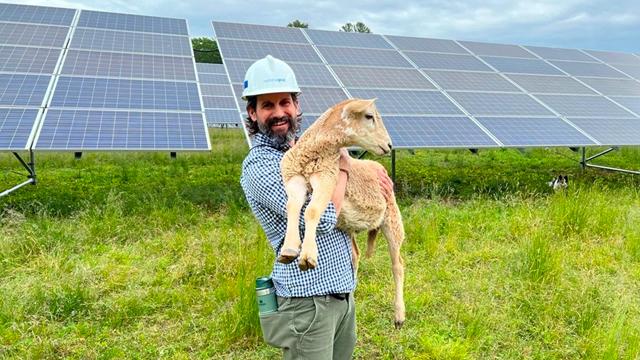
The innovative and futuristic technologies improving our electricity networks
Transitioning the electricity network to maximise on clean and renewable energy brings with it all kinds of new and unexpected challenges. This means we need to constantly look to more innovative and imaginative solutions to keep the networks resilient, operating safely and efficiently as we journey towards net zero.
These are just some of the most innovative and state-of-the-art technologies we’re trialling or adopting, to solve issues or evolve our electricity systems.
1. Robot dog: sniffs out faults and keeps humans safe
What is it?
Spot® is a high-tech ‘robo-dog’, about the size of a Labrador.
Watch Spot in action:
How does it work?
Spot’s job is to carry out critical safety inspections, detect faults and search out potential issues with equipment at sites like substations. It does this using state-of-the-art visual imaging, thermal imaging and acoustic imaging, as well as LiDAR (laser imaging, detection and ranging) for 3D scanning and site mapping.
What are the benefits?
As an autonomous robot, Spot is able to access areas that human engineers can’t while the asset is still operational. This removes the need for lengthy shutdowns, while also improving safety for human engineers.
Status
Spot is in use at the high-voltage Sandy Pond electricity converter station in the US and also trialled across our UK interconnector converter sites.
2. Autonomous drones: performing pilot-free infrastructure inspections of overhead wires, pylons and substations
What is it?
Autonomous drones are able to fly ‘beyond visual line of sight’ to inspect overhead wires, pylons and substations without the intervention of a pilot. They use artificial intelligence (AI) to deal with unforeseen or unpredictable situations.
This differs from the drones currently being used for infrastructure inspections, which require their pilot to be present on site and whose routes are pre-determined; meaning the pilot must take control of the drone in unforeseen events for which the drone hasn’t been programmed.
See our drones in action:
How does it work?
Drones allow us to look at parts of our network that are more difficult or costly to reach. They make it much easier to inspect overhead wires, pylons and substations without the need for power outages, scaffolding or cherry pickers.
Autonomous drones can be remotely accessed from anywhere in the world. These drones can be automatically deployed, recovered and recharged without the need for an onsite pilot.
A cloud-based AI model will process the data and images collected by the drone, automatically detecting defects and producing near real-time asset condition reports.
What are the benefits?
Drones have already been proven to save us both time and money, as well as making a huge difference in how we can plan our maintenance work. By adopting an autonomous drone system to perform condition monitoring surveys, we can make our maintenance activities even safer, more efficient and more environmentally friendly.
Status
Autonomous drones are being trialled at the Deeside Centre for Innovation in the UK, to perform aerial thermal substation inspections. We're also trialling them in the field to carry out detailed close-quarter inspection of steelwork and components on the transmission network.
3. LineVision: helping up to 40% extra flow through power lines
What is it?
LineVision is a startup in the National Grid Partners investment portfolio. Attaching LineVision sensors to continually monitor electricity transmission lines provides real-time data in order to calculate a ‘dynamic line rating’ (DLR). This rating can then be used to maximise the amount of power that can safely be transmitted through that transmission line.
Combined with the construction of new infrastructure, this innovative technology forms part of National Grid’s work to upgrade and adapt the electricity network to meet increased demand and help deliver a net zero grid.
Read more about how we’re upgrading the UK’s electricity grid
How does it work?
The dynamic line rating is determined by a power line’s physical and electrical properties; this includes size, resistance and maximum safe operating temperature, as well as the local weather conditions.
Historically, a ‘static’ line rating was used to operate transmission lines, calculated using conservative and static values for assumed weather conditions.
LineVision’s dynamic line ratings determine capacity limits by combining real-time conductor properties and forecasted weather conditions. This enables more informed grid operations, as well as safely increasing operational limits.
See Linevision being installed:
What are the benefits?
By increasing capacity and allowing more renewable power to flow, LineVision has the potential to unlock 600MW of additional capacity in the UK’s electricity transmission network; enough to power more than 500,000 homes and save £1.4 million in network operating costs per year.
In the US, the project is expected to add enough capacity to existing power lines to power around 80,000-100,000 homes.
Status
LineVision has been successfully implemented on National Grid’s networks in New York and Massachusetts, delivering an average increase in transmission capacity of over 30%. A two-year trial is now being conducted on a 275kV circuit between Penwortham and Kirkby in Cumbria, UK.
4. AI satellite technology: supporting our biodiversity and natural environment
What is it?
AiDash – a National Grid Partners portfolio company – has developed a system that provides both Intelligent Vegetation Management and Intelligent Sustainability Management.
How does it work?
During an initial proof of concept, we used AiDash to identify where vegetation should be pruned near to electric circuits. The system uses satellite imagery to locate problems on assets like power lines, coupled with an Artificial Intelligence (AI) dashboard that makes predictions about which areas need immediate attention.
Near real-time imagery of tree and shrub conditions along the networks helps us to predict the probability of overgrown vegetation causing a circuit to malfunction or experience an outage. The satellite imaging can capture a top-down picture of the entire network, as well as imagery based on different angles.
Using the same technology, Intelligent Sustainability Management can map the land type and measure the biodiversity level of habitats that our networks pass through, providing an alternative solution to on-the-ground surveying methods.

What are the benefits?
By making the process of environmental surveys and audits less complex, this technology helps to:
- remove many of the challenges of using traditional on-the-ground surveying methods
deliver ‘biodiversity net gain’ – ensuring that habitats are left in a better state than they were before development – by making data-driven environmental improvements
increase cost savings and other efficiencies
save weeks of work in the field by eliminating the frequent land surveys that are currently performed manually
identify how each circuit might perform in the next year based on the amount of vegetation surrounding it
quantify biodiversity to plan sustainable land development and restoration initiatives based on the environmental value of varying habitats.
Status
AiDash's Intelligent Vegetation Management technology has been applied to National Grid’s entire US business. After a year of using the information gained from the proof of concept, we realised approximately $2 million in efficiencies.
In the UK, we’re in the early stages of using AiDash’s Intelligent Sustainability Management technology to help us plan biodiversity enhancements and track our progress against our sustainability commitments.
5. Molten metal manipulation: Stopping SF6 leaks without pausing power
What is it?
This innovative solution uses low-melting-point molten metal to rapidly fix leaks of sulphur hexafluoride (SF6) greenhouse gas in our substations.
SF6 is an insulating gas commonly used in high-voltage electricity equipment to prevent short circuits and to keep networks safe and reliable.
How does it work?
This solution involves applying a mould to the leaking pipework into which a low melting-point liquid alloy is injected. As the seal requires no curing time once it’s solidified, it can be applied to equipment that’s in service.
Repairs can be completed in both challenging and difficult to access environments, without the need for hot work. Reapplication is straightforward and recovered alloys can be reused.

What are the benefits?
SF6 is a potent greenhouse gas with a global warming potential thousands of times greater than CO2, so stopping leaks is crucial in tackling climate change.
Previously fixing such a leak in a substation would require a planned outage while the gas is removed, the repairs carried out and the gas refilled again. But this cutting-edge technology is helping to reduce SF6 leaks without the need to drain systems or shut down processes, so it both reduces environmental impact and keeps electricity flowing around the country.
Status
Following an initial UK pilot trial at the Deeside Centre for Innovation, and further studies at Cardiff University, this molten metal technology has been successfully rolled out in the field at Dinorwig and Sizewell substations – meaning that while leak repairs took place power could continue flowing to the grid from two of the country’s largest hydroelectric and nuclear plants.
Find out more about SF6 and plans to replace it with greener alternatives
6. Solar Grazing: a natural way to keep solar panels working effectively
What is it?
The large area of land that’s generally required for a utility-scale solar project comes with a large challenge; how to maintain grass that grows underneath and around the solar panels.
A more ‘nature-based’ solution for this is Solar Grazing – using grazing animals to cut the grass.
It may not be technology per se, but sheep are the best for this job as they don't like to eat cables and don't jump on top of the solar panels like goats would. The solar panels also provide shade for the sheep during the hot summer months.
How does it work?
The grass is kept even by ‘rotational grazing’, which means that the shepherd moves the sheep around the solar sites using small solar-powered electric fences that are rotated once a week.
The sheep live on the solar sites for the entire season (from April to October) and the grass provides the nutrients and minerals they need to grow healthy.
By the end of the season, part of the flock goes to local markets, creating a thriving local regenerative food system, and others ensure the next generation of ‘lamb-scapers’ continues growing the operation.

What are the benefits?
Some key benefits include:
increased soil biodiversity thanks to the sheep's eco-friendly fertiliser (in the form of manure)
an improved soil biodiversity that increases the soil's potential for carbon sequestration, by ensuring plants have healthy root systems that push carbon molecules deeper into the ground
reducing the need for herbicides and pesticides, as well as carbon emissions that would come from lawnmowers
cost-effectiveness: solar grazing is usually cheaper than traditional landscaping
reduced noise pollution: neighbours generally prefer the sound of sheep over the sound of lawnmowers.
Status
A solar grazing pilot is currently running at two of our solar facilities in Attleboro, Massachusetts. By the end of the 2023 growing season, we expect to gradually start scaling up this pilot to the rest of our solar sites where solar grazing may be feasible – potentially 18 out of our 30 sites across Massachusetts.
Published: 14 August 2023
The information in this article is intended as a factual explainer and does not necessarily reflect National Grid's strategic direction or current business activities.



